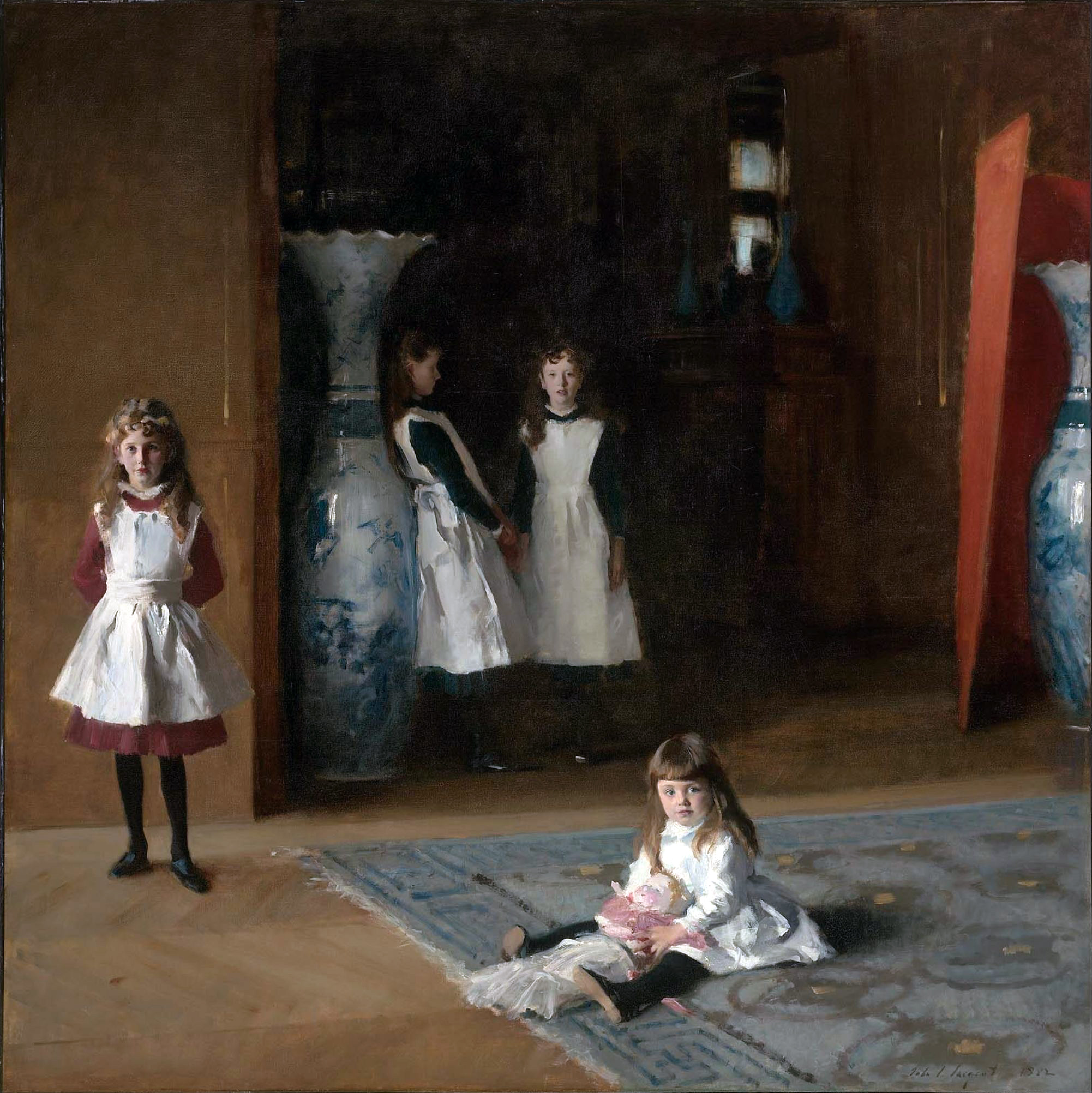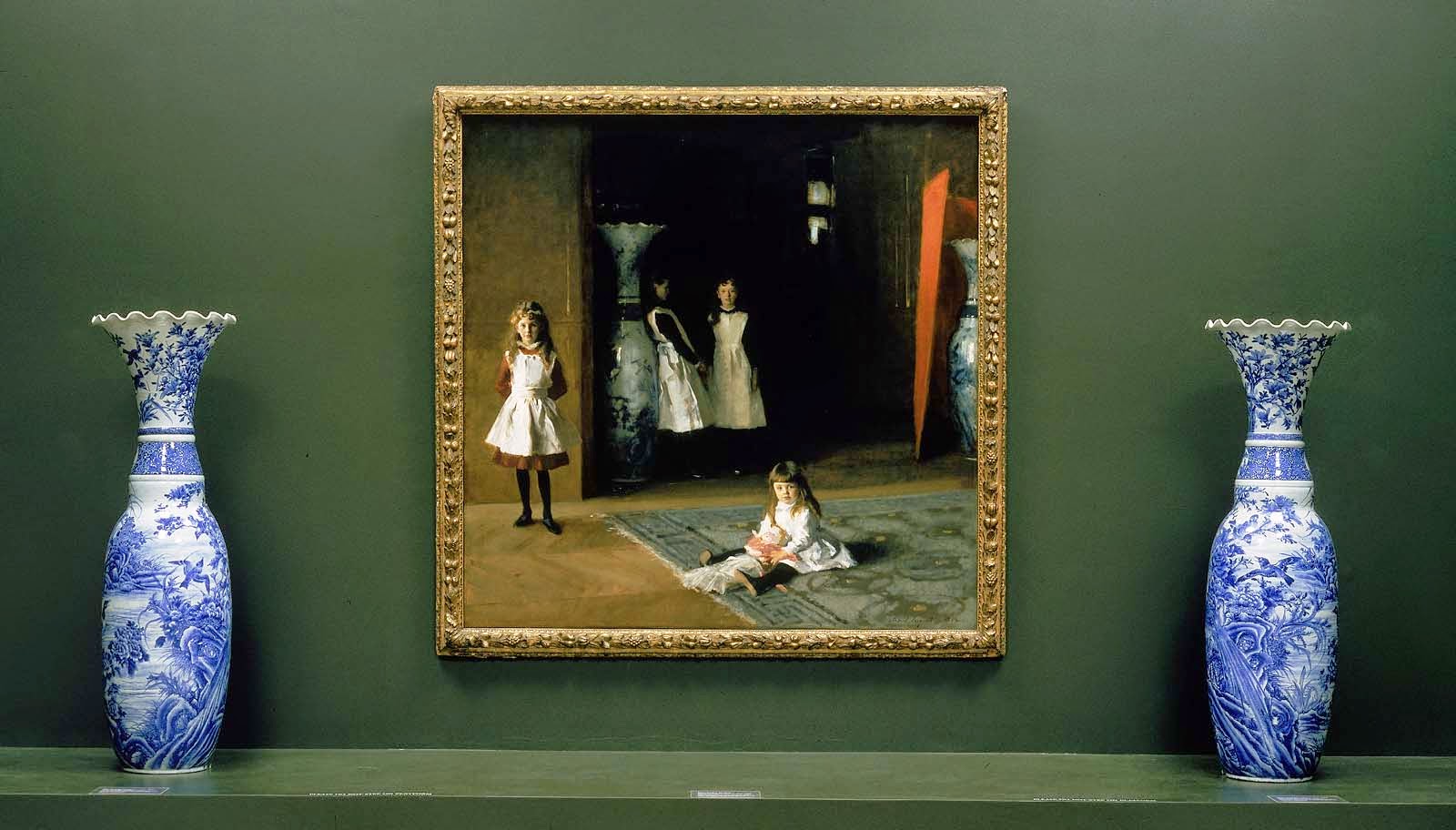/Portraits d'Enfants
Framing Absence
from 09/17/2024, by uni — 8m read
I first became interested in Sargent's work when I read about the controversial Portrait of Madame X. His ability to capture the essence of a person, to show the layers beneath their outward appearance, struck me. It’s not just a likeness he portrays; it's as if the person in the painting has a hidden life that extends beyond the canvas. When viewing his work, you don't merely see brushstrokes and texture - you feel as if you’ve entered the portrait's reality.
The first Sargent painting I saw in person was the cult-like but elegant Fumée d'ambre gris (Smoke of Ambergris) at the Clark Art Institute. This encounter deepened my appreciation for his craft, as he effortlessly blended realism with a sense of the ethereal. As I delved further into his works, I found a favorite that has continued to captivate me with its haunting beauty and psychological depth: The Daughters of Edward Darley Boit.
John Singer Sargent was well-acquainted with the Boit family, primarily through Edward Darley Boit, an American expatriate and fellow artist living in Paris. Boit was an amateur painter and a wealthy man who had established himself in Parisian society. He and Sargent moved in similar social circles, often mingling with artists, intellectuals, and expatriates. Sargent and Boit shared a close friendship, and it was through this relationship that Sargent came to paint The Daughters of Edward Darley Boit in 1882. The Boit family lived in a grand Parisian apartment (32, Avenue de Friedland), where Sargent spent considerable time observing and capturing the lives of Boit’s four daughters - Julia, Mary Louisa, Jane, and Florence.

Figure 1: The Daughters of Edward Darley Boit (1882)
John Singer Sargent's The Daughters of Edward Darley Boit immediately captivates with its unconventional composition. The scene unfolds within the Boit family's Parisian apartment, depicted from a slightly skewed angle, tilted to the right. Sargent opts for an abstracted depiction of the setting; the wooden walls and floor are stripped of detail, enhancing the room's starkness. Sunlight filters in from the left, illuminating the two younger daughters in the foreground. In contrast, the unlit void at the center serves as a shadowy enclave for the older sisters. The room’s depth fades into an indeterminate darkness, where a fireplace and mantel quietly sit, adorned with small blue vases and a decorative mirror. These minor vases act as counterparts to the larger, more dominating Japanese porcelain vases that anchor the left and right edges of the composition. Complementing the blue tones of these vases is a Persian-style rug that anchors the lower left of the painting.
This rug becomes an island for the youngest daughter, four-year-old Julia, who gazes out at the viewer, radiating innocence. The rug seems to symbolize parental favoritism and a protective barrier against the external world. Its soft, plush texture creates a literal and figurative cushion, contrasting with the room’s polished, harder floor. Julia is dressed in a monochrome outfit, her white pinafore layered over a white top, perhaps suggesting that her parents view her as an angelic figure, untouched by the complexities of growing up and not yet matured enough to assimilate into her own colors. In her arms, she holds a china doll - interestingly, the doll is dressed in pink, adding a subtle irony to the scene.
Standing to the left is eight-year-old Mary Louisa, who, unlike her sisters, adopts a more formal pose, as though accustomed to portraiture. The sunlight catches her white pinafore, accentuating the elegant detailing of its folds and shadows. This white garment contrasts with the maroon fabric of her dress, adding a layer of complexity to her attire. The wooden wall behind her serves as a flat backdrop, isolating her within the composition; it's almost as if this segment could stand alone as a portrait of just herself. Mary Louisa’s placement at the periphery of the group suggests a liminal space, visually metaphorizing the adolescent experience of being caught between childhood and adulthood. Her isolated position and contemplative expression hint at a burgeoning independence, poised on the threshold of leaving behind the innocence of youth.
Further back stand the eldest sisters, Jane (twelve) and Florence (fourteen), who introduce an unsettling tone to the painting. Their presence, partially obscured by darkness, creates a sense of dread, a haunting quality that permeates the shadowy void around them. Florence, positioned on the left, avoids the viewer’s gaze, her body turned away. She leans against the left Japanese vase, her posture conforming to its curves. Jane faces the viewer more directly, though her expression remains solemn and distant. Both girls wear blue tops beneath their white pinafores, suggesting a visual connection yet emotional separation, each absorbed in her own internal world. Not yet completely engulfed by the void, they appear to be nearing the end of their journey through childhood, teetering on the brink of the unknown.

Figure 2: The Japanese vases standing in gallery with the painting
The giant vases that frame the composition are not mere decorative objects; Sargent imbues them with a personified presence that fills the narrative gaps. These six-foot-tall porcelain vases, crafted in Arita, Japan, loom over Florence, casting shadows that metaphorically represent parental and societal expectations. They dominate the space, actively guarding the future paths of the Boit daughters. The apartment, more a museum than a home, feels devoid of the spirit of play, an oppressive setting where the sisters seem more like exhibits than inhabitants. The half-visible vase on the right is particularly telling, symbolizing the absence of a parental figure, likely their mother, who suffered from bipolar disorder. The daughters understand how easily these vases could tip and shatter, fundamentally altering the societal expectations they represent, yet they lack the courage to disrupt this fragile balance.
Despite their shared features, little about these figures suggests familial unity. It’s a portrait of a family devoid of familial warmth. The daughters appear as spectral presences, more like ghosts than living beings, trapped in this room as if they too are part of the collection. The porcelain vases shine with a glaze that starkly contrasts the lack of sparkle in the girls' expressions. The right vase, partially hidden by a red screen, insinuates that the parents are more protective of their material wealth than their own children.
Sargent's modernist approach rejects the conventional portraiture of posed smiles and idealized family dynamics, instead presenting the raw, unfiltered reality of the Boit daughters' lives. This approach aligns with the modernist ethos of presenting life authentically, without romanticization. As the girls age, they seem to withdraw further from their surroundings, embodying a descent into a central void that represents the dangers of independence without guidance.
Sargent offers three triangular structures that guide the reading of the composition. The first is the daughters themselves - isolated and distant from one another, each a portrait in her own right, arranged from youngest to oldest, front to back. The viewer's eye moves from Julia on the rug, to Mary Louisa against the wooden backdrop, and finally to Jane and Florence in the encroaching darkness. The second trio is the Boit family's museum pieces: the two Japanese vases and the rug, all rendered in a cool porcelain blue. Intriguingly, the eldest daughters align perfectly between the two vases and wear similar blue tones, perhaps hinting at their loss of innocence and how their parents view them - as objects. The final triangle consists of reds, always positioned to the left of the blue elements. Mary Louisa’s red dress stands to the left of the blue vase, Julia's pink china doll lies on the left side of the blue rug, and the red screen shields the right vase. Red thus emerges as a symbol of protection, safeguarding innocence that has yet to be fully stripped away.